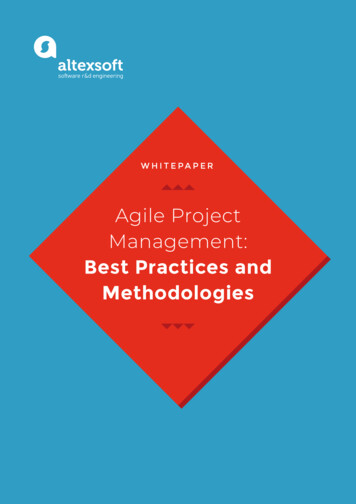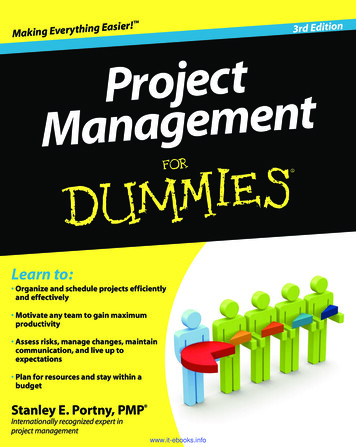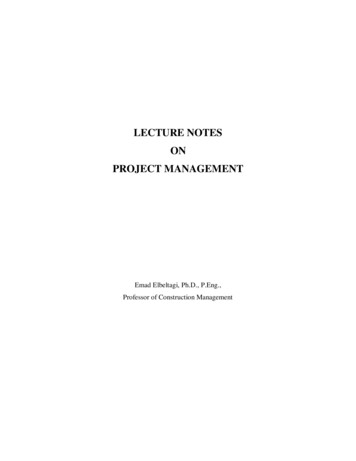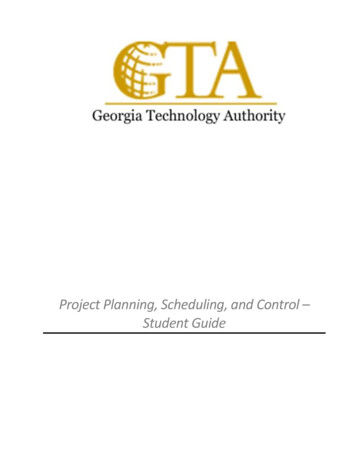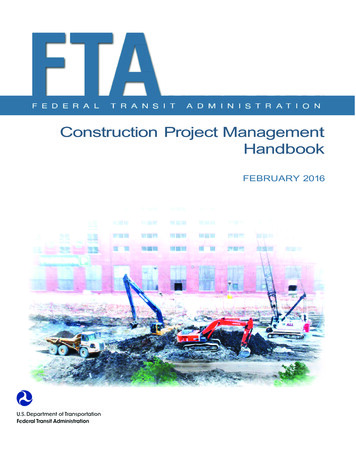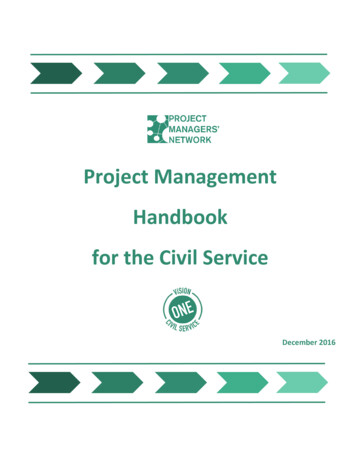
Transcription
Project ManagementHandbookfor the Civil ServiceDecember 2016
Civil ServiceProject Management HandbookPrefaceIncreasingly the work of civil servants comprises of sets of projects; projectsto evaluate how services and polices are working, projects to introduce newservices and policies, projects to change how existing services and policiesare implemented and managed, and projects to deliver once-offprogrammes and events. In a world of competing priorities, tight deadlinesand scarce resources, the art and skill of project management is now a corecompetency for all managers.The purpose of this handbook is twofold. First to support managers by givingthem an easy reference guide to the core principles and methodologies ofproject management and second, to promote a standardised and consistentapproach to project management across the civil service. The handbook hasbeen designed for use by Government Departments1 but can be used by anyorganisation.The handbook also provides a standardised five step framework for a phasedapproach to the proposal, initiation, planning, execution and closure ofprojects within the Civil Service. It is based on proven models currently in useacross the Civil Service, on recognised best-practice in the field of projectmanagement and international standards. It should be used as an importantreference and resource, coupled with experience, professional judgment andinitiative.This handbook also recognises that a ‘one size fits all’ approach is notappropriate as Departments are not uniform in their structure, size,functions, locations etc. and therefore each must make pragmatic decisionsin applying this core guidance to reflect their own responsibilities and1The Civil Service comprises all Departments as defined by the Public Service Management Act 1997, all offices orbranches of the Public Service specified in Part I or in Part II of the Schedule to that Act and ‘Vote Holding’ bodiesunder the aegis of those Departments and Offices-1-
Civil ServiceProject Management Handbookcircumstances. However, a common language and an approach on certainproject management issues must exist across Departments. In this regard,this handbook should be considered in its entirety to ensure acomprehensive perspective.-2-
Civil ServiceProject Management HandbookTable of ContentsForeword .81Core Components of Project Management .91.1Project Management Definitions and Pre-Requisites .91.1.1 Definitions . 91.1.2 Pre-Requisites . 101.2 Project Management Principles for the Civil Service .1221.3Applicability .151.4Relevant Legislation, Standards and Guidelines .181.5Definitions/Terminology .19Project Portfolio Management Framework (PPM), Project Lifecycle and ProjectManagement Phase Gate Approval Process . 2032.1PPM Overview .202.2Project Life Cycle .212.3The Phase Gate Approval Process .242.4Phase Gate Reviews and Expected Gate Outputs .29Governance, Roles and Responsibilities . 313.1Governance Overview .313.2Project Roles and Responsibilities.343.3Project Decisions .374Stakeholder Engagement and Communication Management . 385Scope Definition and Management . 406Work Breakdown Structure (WBS) and Project Scheduling . 427Project Cost and Procurement Management . 4587.1Cost Management .457.2Procurement Management .46Project Risk and Issues Management . 478.1Risk Management .478.2Issues Management .49-3-
Civil ServiceProject Management Handbook9Project Reporting . 5010 Change Management . 5210.1Integrated Change Control .5210.2Change in Organisations.5211 Quality Management . 54Typical Project Lifecycle Phase Overview . 5612 Pre-Project Phase Description . 5712.1 Phase Purpose .5712.2 Key Activities, Inputs and Outputs .5712.3 Key Deliverables .5812.4 Key Roles and Responsibilities .5812.4.1 Project Sponsor . 5812.4.2 Stakeholders (Internal) . 5812.4.3 PMO (where one exists). 5812.5 Expected Phase Gate Outputs .5813 Initiation Phase Description . 5913.1 Phase Purpose .5913.2 Key Activities, Inputs and Outputs .5913.3 Key Deliverables .6013.4 Key Roles and Responsibilities .6012.4.1 Project Sponsor . 6013.4.2 Project Manager . 6013.4.3 Work Stream Leader . 6013.4.4 Stakeholders (Internal) . 6013.4.5 PMO . 6113.5 Expected Phase Gate Outputs .6114 Planning Phase Description . 6214.1 Phase Purpose .6214.2 Key Activities, Inputs and Outputs .6214.3 Key Deliverables .6314.4 Key Roles and Responsibilities .6414.4.1 Project Sponsor . 64-4-
Civil ServiceProject Management Handbook14.4.2 Project Manager . 6414.4.3 Work Stream Leader . 6414.4.4 PMO (where one exists) . 6414.5 Expected Phase Gate Outputs .6415 Execution Phase Description . 6515.1 Phase Purpose .6515.2 Key Activities, Inputs and Outputs .6515.3 Key Deliverables .6615.4 Key Roles and Responsibilities .6615.4.1 Project Sponsor . 6615.4.2 Project Manager . 6615.4.3 Work Stream Leader . 6715.4.4 PMO (where one exists) . 6715.5 Expected Phase Gate Outputs .6716 Closure Phase Description . 6816.1 Phase Purpose .6816.2 Key Activities, Inputs and Outputs .6816.3 Key Deliverables .6916.4 Key Roles and Responsibilities .6916.4.1 Project Sponsor . 6916.4.2 Project Manager . 6916.4.3 Work Stream Leader . 6916.4.4 Project Stakeholders . 7016.4.5 PMO (where one exists) . 7016.5 Expected Phase Gate Outputs .70ICT Related Project Lifecycle Phase Overview . 7117 Plan and Analyse Phase Description . 7217.1 Phase Purpose .7217.2 Key Activities, Inputs and Outputs .7217.3 Key Deliverables .7317.4 Key Roles and Responsibilities .7317.4.1 Project Sponsor/Product Owner . 7317.4.2 Project Manager/ Scrum Master/Team Lead . 7417.4.3 Stakeholders . 74-5-
Civil ServiceProject Management Handbook17.4.4 PMO (where one exists). 7417.5 Expected Phase Gate Outputs .7418 Design Phase Description . 7518.1 Phase Purpose .7518.2 Key Activities, Inputs and Outputs .7518.3 Key Roles and Responsibilities .7618.3.1 Project Sponsor/Product Owner . 7618.3.2 Project Manager/ Scrum Master/Team Lead . 7618.3.3 Project/Development Team . 7618.4.4 Stakeholders . 7718.3.5 PMO (where one exists) . 7718.4 Expected Phase Gate Outputs .7719 Build and Early Test Phase Description . 7819.1 Phase Purpose .7819.2 Key Activities, Inputs and Outputs .7819.3 Key Deliverables .7919.4 Key Roles and Responsibilities .8019.4.1 Project Sponsor/Product Owner . 8019.4.2 Project Manager/ Scrum Master/Team Lead . 8019.4.3 Project/Development Team . 8019.4.4 PMO (where one exists) . 8119.5 Expected Phase Gate Outputs .8120 Test and Integration Phase Description . 8220.1 Phase Purpose .8220.2 Key Activities, Inputs and Outputs .8320.3 Key Deliverables .8320.4 Key Roles and Responsibilities .8320.4.1 Project Sponsor/Product Owner . 8320.4.2 Project Manager/Scrum Master/Team Leader . 8420.4.3 Project/Development Team . 8420.4.4 PMO (where one exists) . 8420.5 Expected Phase Gate Outputs .8421 Deploy, Maintain and Evaluate Phase Description . 8521.1 Phase Purpose .85-6-
Civil ServiceProject Management Handbook21.2 Key Activities, Inputs and Outputs .8521.3 Key Deliverables .8621.4 Key Roles and Responsibilities .8621.4.1 Project Sponsor/Product Owner . 8621.4.2 Project Manager/Scrum Master/Team leader . 8721.4.3 Project/Development Team . 8721.4.4 Project Stakeholders . 8721.4.5 PMO (where one exists) . 8721.5 Expected Phase Gate Outputs .8722 Fast Track Process . 88Appendix 1Project Scaling Matrix . 89Appendix 2Definitions/Terminology . 92Appendix 3PM Toolkit available to support Handbook . 105-7-
Civil ServiceProject Management HandbookForewordThere isn’t a person in our country who is not dependent in some way onthe services designed, developed or delivered by the Civil Service. Whetherit is in education or travel, security or defence, enterprise or welfare,taxation or agriculture, employment rights or health, arts or sport, housingor transport, everyday all of the people who live in Ireland and many of ourcitizens abroad benefit from the services that we design, develop or deliveron their behalf. To do this, we work with 35,000 colleagues to managebillions of euro worth of current and capital expenditure and oversee theactivities of organisations that employ a further 300,000 people. And weaccount for the quality of our work to the Government, the Oireachtas, theOmbudsman and increasingly, through the Open Government agenda, tothe public.Well-managed projects are critical to how we work, to the successfulachievement of Government priorities, to the management of publicfinances and, most importantly, to the delivery of high quality services tothe public. Project Management supports the identification andestablishment of milestones to be achieved across projects, it helps withthe prioritisation of activities and the effective allocation of scarceresources, it enables the monitoring and the reporting of progress, and itprovides a solid basis for sound financial management and control. The CivilService Management Board has approved this Project ManagementHandbook to provide a common framework for the development,management and delivery of projects. This framework is based on keyprinciples and recognised best-practice in the field of project managementand international standards. It is designed to build on the existing projectmanagement skills and professionalism of the Civil Service, to improve thefocus on outcomes and ensure a more consistent approach in the deliveryof projects across the Civil Service.Civil Service Management Board-8-
Civil ServiceProject Management Handbook1Core Components of Project Management1.1 Project Management Definitions and Pre-Requisites1.1.1 DefinitionsA generally accepted definition of a project is:“A Project is defined as a temporary endeavour undertaken to create aunique product, service or result. The temporary nature of projectsindicates a definite beginning and end.The end is reached when the project’s objectives have been achievedor when the project is terminated because the objectives will not orcannot be met, or when the need for the project no longer exists.”2Having regard to the varied activities carried out across the Civil Service, theCivil Service Management Board defines a project as follows:“A project is a unique set of coordinated activities, with definedstarting and finishing points, undertaken by an individual or team tomeet specific outcomes and objectives within defined time, cost andperformance parameters. A project may or may not be part of a widerprogramme.3”The Civil Service Management Board also defines Project Management asfollows:“Project Management is the application of a methodology, knowledge,skills and techniques to effectively and efficiently execute a project.”2A Guide to the Project Management Body of Knowledge - PMBOK Guide – Fifth Edition 2013 PMI“Practical Programme Management Driving Public Service Reform” – Department of Public Expenditure and ReformNovember 2015 ads/Practical-Programme-Managementfinal1.pdf3-9-
Civil ServiceProject Management Handbook1.1.2 Pre-RequisitesThe Civil Service Management Board recognises that for effective projectmanagement, an organisation (and this can also be a temporary structuredesigned to implement the desired outcome) needs three things: Governance Processes and PeopleGovernanceProcessPeopleGovernanceSound governance is required to: ensure that there is clarity of purpose with regard toproject/programme objectivesprioritise projects (within a programme)set the right milestones and performance targetsmonitor progress and oversee project execution to ensureproject adheres to the original scope and business caseestablish the right organisation approach and methods toproject /programme oversight- 10 -
Civil ServiceProject Management HandbookGovernance arrangements should be established that are proportionate andunambiguous and that align with the governance structures of thesponsoring/partnering organisations4.ProcessThere is a need to recognise that good processes are those that enableanyone (in the organisations) involved in the project to: speak the same language with the same understanding as otherproject membersunderstand how projects and project activities are ordered andmanaged in a structured, logical and organised way, followingdefined stepsunderstand their role, responsibility and reporting line within theprojecthave an understanding as team members of their interdependency on each other and the integrated nature of projectworkbe informed as to progress against the project plan.PeopleProjects should be resourced with sufficient people having a suitable mix ofsubject matter expertise and project management skills to enable the projectto be delivered. Subject to this condition being satisfied, project assignmentsprovide an opportunity to provide staff with a new developmental workexperience and in particular where projects are cross-cutting/crossdepartment in nature.4Corporate Governance Standard for the Civil Service – Department of Public Expenditure and Reform November2015- 11 -
Civil ServiceProject Management Handbook1.2 Project Management Principles for the Civil ServiceBuilding on these definitions and pre-requisites, the Civil ServiceManagement Board has identified the following ten principles to guideproject management within the civil service. The precise approach in whicheach principle should, in practice, be applied is proportionate to the scaleand nature of the project in question.1.2.Project Governance: Project Governance provides a comprehensiveand consistent method of controlling projects and ensuring theirsuccess. Sound governance requires an agreed, appropriate andproportionate decision making structure through which the objectivesof a project are set, implementation approach is agreed andperformance is monitored. The governance structure should alsoensure that lines of communication are established and work wellbetween members of the project and that all parties are well briefed onthe project objectives, the project approach and the project progress.These parties include the project management team, the projectsponsor, the permanent client/organisation and other key stakeholdersincluding, if appropriate depending on the nature of the project, theGovernment, other public bodies, affected individuals and businesses5.Depending on the scale and complexity of the project the projectgovernance structure may include a full-time project managementoffice (PMO).Roles and Responsibilities: It is important that adequate time is spentto ensure that precise roles and responsibilities are well defined andassigned to appropriately skilled and experienced people, with lines ofauthority, responsibility and accountability clearly identified anddefined in the project organisational structure to avoid gaps inownership and risk to delivery.5Draft Consultation Principles/Guidance for Public Consultation-Department of Public Expenditure and Reform July2015- 12 -
Civil ServiceProject Management Handbook3.Objectives and Benefits6: The purpose of any project is to achievespecified outcomes. In most cases, once the work is complete, the workwill be handed over to a permanent client organisation for the day-today operations. It is therefore vital that the project goals and objectivesare clearly defined, measurable and achievable. They should also beagreed at the outset of the project between the client organisation, theproject sponsor and the project team. Once objectives have beenestablished, they should be clearly communicated to all staff andstakeholders involved with the project. Record the benefits sought,draw up a plan to deliver them and evaluate success. At the conclusionof the project the project should be handed-over to the clientorganisation with a statement of goals/objectives achieved and benefitsrealised. It is not always possible to assess benefits at the time theproject is closed as these benefits will continue to be derived into dayto day operations. These should be recorded to inform future businessdecisions on similar projects.4.Business case: A business case should be prepared and formallyapproved to identify, record and evaluate the project objectives, theoptions for meeting these objectives, the anticipated cost andtimeframe for each option, and the expected financial and otherbenefits associated with each option. Once an implementation optionis selected, the cost, timeframes and benefits should be updated withactual versus planned/anticipated outcomes as part of the governanceapproach.5.Time Management: A detailed schedule should be prepared at theoutset of the project listing all of the project activities, thedependencies between them, the resources and time required toachieve them, the start and finish date for each activity, the activitytime, key milestones dates, the critical path and the assurance and6Work is underway to develop a Draft Benefits Management Handbook for Public Sector Projects - A Guide toBenefits Management by Department of Public Expenditure and Reform- 13 -
Civil ServiceProject Management Handbookreview activities (e.g. governance/project team meetings). Subject tothe scale and complexity of the project this schedule should be revisedand updated on an ongoing basis by the project team to record theactual against the planned. One of the keys to a successful project is theplanning phase. Time well spent in the early planning stages will helpimprove the probability of project success.6.Risk Management: Effective risk management supports goodgovernance as it assists in analysing uncertainties, in clarifyingaccountabilities and in demonstrating how the public interest is bestserved7. Project risk management is the structured process ofunderstanding the risks inherent in a project and their likely impact. Itinvolves identifying, analysing, assigning ownership and respondingthrough mitigating actions to risk factors throughout the life of aproject. Each project should undertake a formal risk assessment(identified risks being ranked according to their probability and impact)and depending on scale construct a risk register for review at eachproject team/project governance meeting.7.Resource Management: Each project should identify the financial andother resources, inside and outside the organisation, required to meetobjectives and ensure they are managed, monitored and utilised.Projects should be resourced with sufficient people having a suitablemix of subject matter expertise and project management skills to enablethe project to be delivered.8.Stakeholder Engagement: Effective stakeholder management is criticalto the effective development, specification and delivery of all projects.Projects should include a stakeholder management plan to identify andset out an engagement approach for those people/organisations most7Risk Management Guidance for Government Departments and Offices – Department of Public Expenditure andReform February 2016;“Risk Management Handbook for Public Service Reform” Department of Public Expenditure and Reform uploads/Risk-Management-Handbook.pdf- 14 -
Civil ServiceProject Management Handbookinterested
Project Management Handbook - 1 - Preface Increasingly the work of civil servants comprises of sets of projects; projects to evaluate how services and polices are working, projects to introduce new services and policies, projects to change how existing services and policies are





